Both roles build products customers love. A Product Manager (PM) owns the product’s outco—customer value, business impact, and roadmap. A Technical Product Manager (TPM) owns the product’s technical feasibility and execution depth—systems design choices, platform constraints, and engineering trade-offs. If your product has complex architecture, heavy integrations, or platform work, hire a TPM. If you need market discovery, positioning, and cross-functional alignment, hire a PM. Many teams need both.
First, definitions (and a quick naming caveat)
- Product Manager (PM): Leads what to build and why. Focus on customers, markets, strategy, prioritization, and measurable outcomes.
- Technical Product Manager (TPM): A PM with deeper technical fluency who bridges product strategy with system-level execution. They translate business goals into architectural decisions and technical scopes.
- Important: Some companies use “TPM” to mean Technical Program Manager (a coordination/program role). This article uses Technical Product Manager. If your org means “program,” adjust expectations accordingly.
Snapshot: TPM vs PM (side-by-side)
| Area | Product Manager (PM) | Technical Product Manager (TPM) |
|---|---|---|
| Core focus | Customer outcomes, value, revenue, adoption | Technical feasibility, performance, platform health |
| Discovery | Market research, user interviews, JTBD | Technical spikes, API audits, dependency mapping |
| Roadmaps | Outcome-driven, themed, business KPIs | Platform/infrastructure roadmaps, sequencing for dependencies |
| Specs | PRDs, success metrics, UX requirements | Technical PRDs, interface contracts, NFRs (latency, SLOs) |
| Stakeholders | Users, execs, sales, marketing, CS | Engineering, architecture, DevOps, security, data |
| Day-to-day | Prioritization, UX trade-offs, go-to-market | System design trade-offs, scalability, integration strategy |
| KPIs | Activation, retention, NPS, revenue, CAC/LTV | Latency/SLO, reliability, build cost, tech debt burn-down |
| Best fit | New products, market expansion, growth work | Platforms, APIs, data/ML products, complex integrations |
Keywords used: “TPM vs PM,” “technical product manager responsibilities,” “product manager responsibilities.”
Responsibilities in practice
Product Manager responsibilities
- Lead customer discovery and define problem statements.
- Craft product vision, strategy, and outcome-based roadmaps.
- Write clear PRDs with success metrics and acceptance criteria.
- Partner with design on user flows and UX trade-offs.
- Align stakeholders and drive go-to-market with marketing and sales.
- Measure results and iterate based on data.
Technical Product Manager responsibilities
- Own technical discovery: spikes, proofs of concept, and risk mapping.
- Translate business priorities into system architecture and integration plans.
- Define non-functional requirements (NFRs)—performance, scalability, security.
- Sequence platform work to unblock feature teams.
- Collaborate with architects to manage tech debt and reliability.
- Review interfaces (APIs/SDKs), data pipelines, and rollout strategies.
Skills: where they overlap—and where they don’t
Shared skills: product sense, prioritization, stakeholder management, analytics, storytelling, and execution.
PM-leaning skills: market analysis, positioning, pricing, UX, experiments.
TPM-leaning skills: systems thinking, API design literacy, SLO/SLA trade-offs, infra costs, security/privacy basics, CI/CD awareness.
Quick test: If a debate hinges on “What problem matters most?” it leans PM. If it hinges on “Can our architecture handle this and at what cost?” it leans TPM.
How each role measures success (KPIs)
- PM KPIs: activation rate, feature adoption, retention, NPS/CSAT, revenue/ARPU, churn reduction, time-to-value.
- TPM KPIs: uptime/SLO attainment, average latency, error budgets, deployment frequency, rollback rate, integration lead-time, cost-to-serve.
When to hire a TPM vs a PM
Choose a PM when:
- You’re pre-product-market fit and need deep discovery and iteration.
- Go-to-market, positioning, and growth levers are your main constraints.
- You need outcome-driven roadmaps and crisp cross-functional alignment.
Choose a TPM when:
- You’re building platforms, APIs, or data/ML products with complex dependencies.
- Performance, reliability, or security are top-line concerns.
- You’re untangling tech debt or migrating to a new architecture (e.g., microservices, event-driven).
- Multiple teams depend on shared infrastructure and need sequencing.
Many scale-ups hire both: a PM for market and growth and a TPM to keep the platform healthy and future-proof.
Collaboration patterns that work
- Dual-track discovery: PM runs user discovery; TPM runs technical discovery. Converge for a single PRD with business outcomes and NFRs.
- Two roadmaps, one plan: An outcome roadmap (PM) and a platform roadmap (TPM) roll up into a single quarterly plan.
- Change management: TPMs lead canary/gradual rollouts, guardrails, and observability; PMs steward comms and customer impact.
Deliverables you’ll typically see
PM deliverables: product vision, OKRs, PRDs, user stories, experiment plans, launch plans.
TPM deliverables: technical PRDs, interface contracts, data schemas, migration plans, runbooks, SLO dashboards.
TPM vs PM vs Technical Program Manager (quick clarification)
- Product Manager: owns what/why and outcomes.
- Technical Product Manager: owns what/why with how at system depth.
- Technical Program Manager (Program): orchestrates cross-team execution, schedules, and risk across many workstreams; may not own product strategy.
Including “technical program manager vs product manager” as a secondary keyword helps capture people who mix the acronyms.
Career paths, transitions, and hiring signals
- PM → TPM: Common for PMs with coding backgrounds or strong API/platform exposure. Upskill in systems design, cloud basics, security, and observability.
- TPM → PM: Common when moving from platforms to user-facing products. Upskill in positioning, pricing, and growth experiments.
- Hiring signals for TPMs: comfort reading architecture diagrams, discussing caching and data models, quantifying latency/cost trade-offs.
- Hiring signals for PMs: crisp problem framing, evidence-based prioritization, strong UX collaboration, and commercial instincts.
Sample job descriptions (condensed)
Technical Product Manager (platform/APIs):
Own the API platform roadmap. Define NFRs and SLOs. Partner with architects to design scalable, secure interfaces. Prioritize tech debt and migrations. Measure latency, reliability, and integration lead-time. Communicate trade-offs to business stakeholders.
Product Manager (SaaS feature team):
Lead discovery to define high-impact problems. Create outcome-based roadmaps. Write PRDs with clear success metrics. Collaborate with design on UX. Partner with marketing and sales for launches. Measure adoption, retention, and revenue impact.
Common myths
- “TPMs just write specs for engineers.” Reality: they make system-level trade-offs visible and measurable.
- “PMs don’t need technical depth.” Reality: they need enough to make smart prioritization and risk calls.
- “Choose one or the other.” Reality: the best orgs use both for complex products.
FAQs
What does a Technical Product Manager do?
They connect business goals to architecture. TPMs scope integrations, define NFRs, and ensure the platform can deliver the roadmap reliably and at the right cost.
Do startups need TPMs?
Early on, a strong PM may be enough. Hire a TPM when complexity rises—APIs, data/ML, security, or multi-team dependencies.
Can a PM become a TPM?
Yes. Build systems literacy: data modeling, latency and caching basics, cloud pricing, observability, and rollout strategies.
TPM vs PM salary—who earns more?
Comp varies by market and level. Senior TPMs and PMs often overlap. Complexity, scope, and company stage drive offers more than the title alone.
Is a Technical Product Manager the same as a Technical Program Manager?
No. A Technical Product Manager owns product outcomes with technical depth. A Technical Program Manager coordinates execution across teams.
If your primary challenge is figuring out the right problems and winning the market, start with a PM. If your challenge is building a scalable, reliable foundation and stitching complex systems together, add a TPM. Most growing teams benefit from both perspectives working as one.





